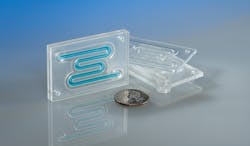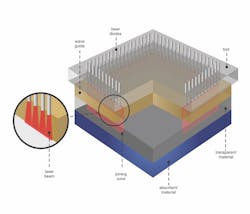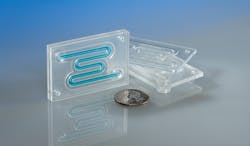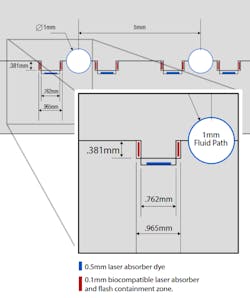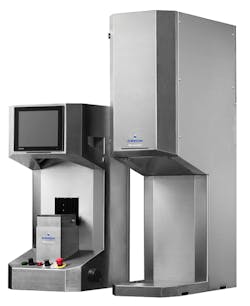New Type of Welding Adds Capabilities to Plastic Laser Welding for Medical Devices
Laser plastic welding has grown in popularity for medical applications because it reliably joins a wide range of materials, including dissimilar materials. At the same time, the process uses no vibration energy, so it is gentle enough to bond plastic parts with thin walls, geometrically complex shapes, and embedded electronics or sensors. At the same time, it can provide a Class A finish. Laser welding is ideal for making medical products that require narrow, particulate-free fluid pathways. Thus, it is often used to make drug-delivery devices, in-vitro diagnostic (IVD) devices, glucose monitors, insulin pumps and similar applications.
Simultaneous through-transmission IR (STTIr) laser-welding technology, developed by Emerson, gives engineers new capabilities for welding plastic parts. That’s partly because it employs a series of laser-emitting diodes to heat the entire weld surface at once. This ensures precise heating and reduces the clamping force required to press parts together while the weld is made and then cools.
Traditionally when welding two plastic parts together, one part had to be “clear” or “transmissive,” which would let the laser pass through without causing warming; the other part then had to be “dark” or “absorptive” to be heated by the laser. This assured the applied laser energy would selectively heat the weld zone of the absorptive part. There, the heat softens the mating edges of both parts, letting them be brought together under compressive force into a clean, particle-free welded assembly.
STTIr welding, combined with precise ultrasonic spray deposition developed by Sono-Tek can weld two optically clear plastic parts made of a wide range of polymers. This opens up new design possibilities for those designing and making medical devices, drug delivery systems and in-vitro testing products.
This new “clear-on-clear” laser process overcomes the traditional transmissive/absorptive part limitation by treating one of the two “clear” mating parts with a biocompatible laser absorber before laser welding. The absorber consists of microparticles of pigment dye or carbon black suspended in a carrier fluid such as isopropyl alcohol or acetone.
The absorber can be added to resin in the form of a masterbatch prior to molding, applied to molded parts using pad printing or, for maximum precision, applied to individual parts with ultrasonic spray-deposition.
Spray deposition relies on an ultrasonic atomizer that precisely deposits the laser-absorbing dye on one of the mating parts, creating a spray pattern as thin as 0.5 mm.
When deposited using the right ultrasonic frequency and spray pattern, the carrier fluid essentially flashes off, leaving a precise pattern of laser-absorbing particles, one micron or smaller in size, on the surface of the thermoplastic. During welding, laser energy gets absorbed by these particles and consumes them, releasing heat that travels through the weld zone of the mating parts, which then become bonded together under compressive force.
Typical targets include the interior surface of tongue-and-groove joints and the interior surfaces of a “double V” joint on one of the mating parts. Precisely depositing the absorber within enclosed joints like these focuses the laser-generated heat needed to create the part-to-part melt and creates a “flash-trap” that contains the melt’s treated area, isolating it from any nearby microfluidic flow paths in the finished assembly.
This new method of plastic laser-welding reliably produces complex fluid paths while maintaining superior aspect ratios in the submillimeter flow path pitch. Such precision is essential for microfluidic parts, which must be reliably bonded, yet maintain consistent dimensions along extremely small flow paths.
This new clear-on-clear laser-welding capability relies on equipment added to the STTIr process (i.e., the biocompatible laser absorber and ultrasonic spray deposition equipment) and it can be “bolted on” to many existing laser-welding applications. It delivers cycle times measured in seconds, making industrial-scale laser welding of medical-quality clear-on-clear microfluidic parts economically viable for the first time. And, since spray deposition can be adapted to coat several parts at once, both the spray-deposition and welding processes can be further scaled up to accelerate production throughputs.
The new process also joins a far greater range of clear thermoplastics, regardless of chemistry. Because the laser-absorbing pigment dye efficiently generates and conducts heat and melt, it can compensate for large differences in the glass transition temperatures (Tg) of different polymers used in mating parts.
A typical example of the process is its use on two clear plastic “coupons” or injection-molded parts that mate to form a serpentine flow path like those found in a host of medical devices. The coupons will become the “absorptive” half of each assembly, so they are placed in the spray deposition equipment for a coating of the laser absorber.
From there, parts are transferred to the laser welder (see photo above), which makes a clear-on-clear, laser-welded part. For medical or IVD devices that demand optically clear flow paths, the technology is invaluable. It simplifies everything from automating blood cell counts in capillary-sized fluid paths to providing visual validation to technicians that a microdose of a powerful therapy is being properly administered to a patient.
The Benefits of Laser Welding
Laser welding offers a range of important benefits to product assembly operations, including:
Superior aesthetics. Manufacturers increasingly use laser welds for their aesthetics because they are precise and flash-free. Weld lines are virtually invisible.
Greater part-design freedom. Traditional plastic welding methods often require flat-plane parts, but laser-emitting waveguides can conform precisely to complicated part geometry, letting lasers weld part designs that maximize aesthetics or functional performance. Laser welding also frees designers to use several reflective compartments or embed sophisticated electronics, sensors, or lighting—such as organic light-emitting diodes (OLEDs) —resulting in more striking, brand-differentiating designs.
Excellent weld quality. Laser welds require no friction, vibrations or movements. Laser-emitting waveguides can conform precisely to even complex parts to ensure rapid and uniform melt across the weld interface. The leaves a uniform, consistently strong weld joint with precise melt-collapse depth and perfect part alignment.
Low mechanical stress. The latest laser welders can manage ultra-low clamp forces, letting delicate and larger parts be joined without introducing mechanical stresses. This eliminates the need for annealing parts and putting them through material stress reduction.
Ultra-cleanliness. Laser welding produces no flash or particulates. It’s a cleanroom-capable process that’s equally at home on any production floor.
Great versatility. Laser-welding technology can bond a wide range of polymer materials, including PC, PA, PS, ABS, elastomers (TPU, TPE), PP HDPE, LDPE, PETG, PBT, PPS, PMMA, PEEK, COC, and more.
Priyank Kishor is a global product manager for Branson laser welding and other non-ultrasonic products at Emerson.
